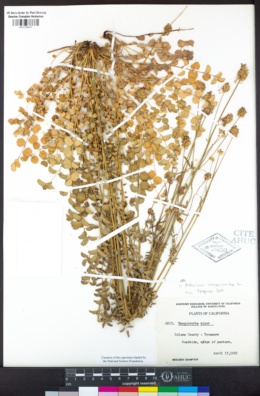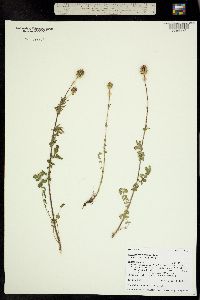
|
|
|
|
Family: Rosaceae
Salad-Burnet, more...small burnet, Small Burnet, salad burnet
[Poterium sanguisorba subsp. muricatum, moreSanguisorba minor Scop., Sanguisorba minor subsp. balearica (Bourg.ex Nyman) F.Muñoz Garmendia & C.Navarro, Sanguisorba minor subsp. magnolii (Spach) Briq., Sanguisorba minor subsp. minor Scop., Sanguisorba minor subsp. muricata (Spach) Nordborg, Sanguisorba minor var. minor Scop.] |
Perennial herb 20 cm - 0.7 m tall Leaves: pinnately compound, stalked (with stipules), with well developed lower leaves and increasingly smaller upper leaves, arching to form a mounded rosette, bearing seven to seventeen leaflets. Inflorescence: a nearly spherical to egg-shaped cluster, 1 - 3 cm across, 0.8 - 2 cm long, with bisexual or male flowers near base and female flowers near tip. Flowers: subtended by bracts, lacking petals but having four green or brown sepals (2.5 - 5 mm long), two pistils, and many drooping stamens. Fruit: 2 semi-egg-shaped achenes enclosed in a four-angled calyx tube. Leaflets: 5 - 20 mm long, egg-shaped to rounded, with three to seven sharp teeth per side. Similar species: Sanguisorba canadensis differs by having 2 cm or longer main leaflets, one pistil, four erect stamens, and one achene. Flowering: late May to early September Habitat and ecology: This species was introduced from Eurasia. In the Chicago Region, it has been found growing on a limestone barren and in turf along the edge of a cemetary. Occurence in the Chicago region: non-native Etymology: Sanguisorba comes from the Latin words sanguis, meaning blood, and sorbeo, meaning "to soak up," referring to the once-thought ability of the plant to stop bleeding by contracting blood vessels. Minor means smaller. Author: The Morton Arboretum Duration: Perennial Nativity: Non-Native Lifeform: Forb/Herb General: Introduced perennial, 25-70 cm tall; stems simple to branched; herbage sparsely pilose to glabrous; caudex woody, often branched; taproot stout. Leaves: Basal (mostly) and cauline, alternate, pinnate, basal and lower cauline blades 10-20 cm long, leaflets 11-21, borne on petiolules, the lower ones alternate, the upper ones opposite, ovate to fan-shaped, 1-2.5 cm long, margins coarsely crenate, upper cauline blades progressively reduced, the leaflets often folded, lanceolate, margins serrate; stipules simple on the lower leaves, 3-lobed on the upper ones; blades petiolate. Flowers: Inflorescence an open, branched cyme; flowers few to several, about 1.5 cm wide, showy; hypanthium silky and puberulent; bractlets lanceolate, 5-6 mm long; sepals triangular, 5-6 mm long, villous, apex acute; petals broad, nearly orbicular, exceeding the sepals, rose- purple to deep red, apex notched; stamens 20-30; pistils numerous, the style usually longer than the achene; flowers July-October. Fruits: Achene, enclosed in a 4-angled, dry, thick hypanthium (fruiting hypanthium), this pear-shaped, 3-5 mm long, prominently ridged with papillae between the winged angles. Ecology: Disturbed habitats, meadows, rocky soils; 1500-2600 m (5000-8500 ft); Apache, Cochise, Coconino, Gila, Mohave, Pima, and Yavapai counties; eastern and western Canada, northeastern, western, and southwestern U.S. Notes: na Editor: Springer et al. 2008 Perennial from a caudex-like rhizome; stems 2-7 dm; lower lvs numerous and well developed, with usually 7-17 lfls, the upper lvs progressively reduced; lfls ovate to rotund, 5-20 mm, with 3-7 sharp teeth on each side; heads several on elongate peduncles, short-ovoid to globose, 8-20 mm; fls subtended by ciliate bracts, the lower ones perfect or staminate, the upper pistillate; sep green or brown, 2.5-5 mm, the inner pair broader than the outer; stamens numerous, the long filaments drooping; pistils 2; mature hypanthium 5 mm, very rough between the wings; achenes 2, semi-ovoid; 2n=28, 56. Native of Eurasia, established as a weed along roadsides and in fields and waste places here and there in our range. May, June. (Poterium sanguisorba) Gleason, Henry A. & Cronquist, Arthur J. 1991. Manual of vascular plants of northeastern United States and adjacent Canada. lxxv + 910 pp. ©The New York Botanical Garden. All rights reserved. Used by permission. |
|
|
|
This project was made possible in part by the Institute of Museum and Library Services [MG-70-19-0057-19].
Powered by Symbiota























































































